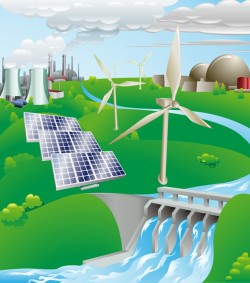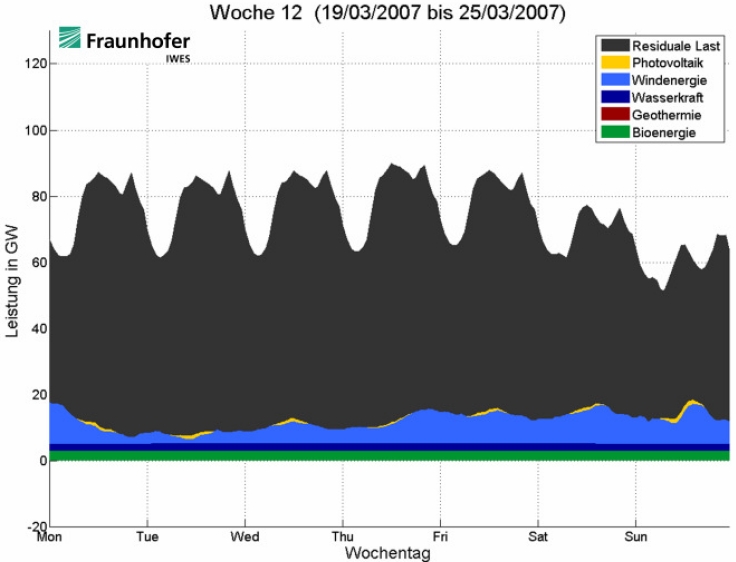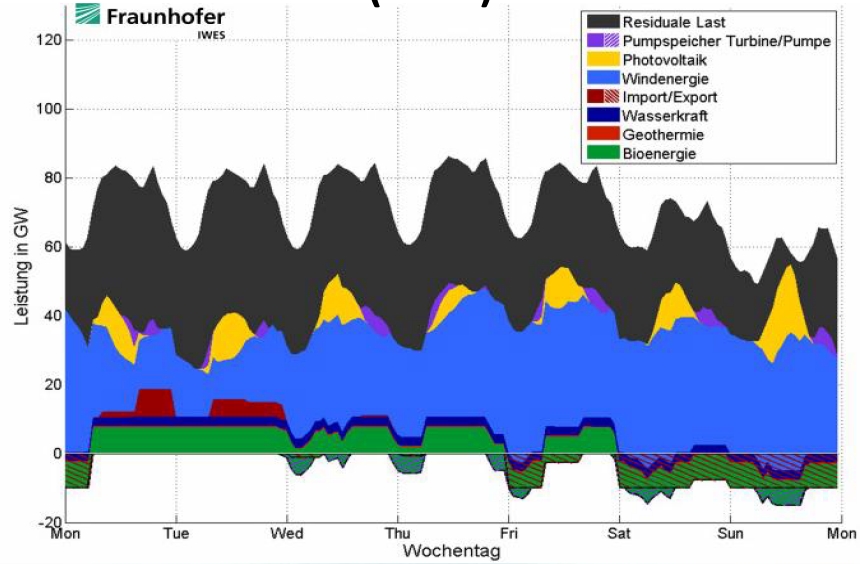 How can we scale up the clean and phase out the dirty?What’s it going to take to substantially ramp up the amount of renewables in the electricity system? There are many nerdy discussions of that question on the interwebs, but lemme try to talk about it in reasonably non-nerdy language.
How can we scale up the clean and phase out the dirty?What’s it going to take to substantially ramp up the amount of renewables in the electricity system? There are many nerdy discussions of that question on the interwebs, but lemme try to talk about it in reasonably non-nerdy language.
There’s a certain amount of demand for electricity that is steady and reliable. Above that, there are fluctuating “peaks” of demand each day, usually evening, when everyone gets home and starts watching TV and running the dishwasher, or in hot areas, the afternoon. For that steady core of demand, we have “baseload” power plants — in the majority of cases, large coal or nuclear plants. Once they’re built they’re pretty cheap to operate and you can run them around the clock. In nerdspeak, they have a high “capacity factor.” However, they’re not well suited to ramping up and down in response to short-term fluctuations. (It takes days to turn a nuke plant off and back on.) To supply power during the fluctuating peaks, we have, appropriately enough, “peaker” plants, which can be turned on and off quickly. (Nerdspeak: they’re “dispatchable.”) Generally speaking, these are natural-gas plants, which are smaller and easier to cycle, though the power is somewhat more expensive.
So you’ve got your baseload plants and your peaker plants. The fundamental problem with renewables, according to conventional wisdom, is that they are neither. They are variable and intermittent, with low capacity factors, so they can’t satisfy baseload demand. But the wind and sun are not dispatchable, so they can’t reliably satisfy peak demand either. They are an unholy mutt, a square peg for a system with two round holes.
In the U.S., already so resistant to change, the reaction has been to say, “Bummer, renewables can’t do much, woulda been nice.” When I was in Germany recently, though, the reaction among folks I talked to was, “Yes, that is a problem. We are going to solve it!” They don’t see it as the reason they can’t integrate lots of renewables. They see it as what has to be done to integrate lots of renewables. The dispute is between the Merkel government, which wants 80 percent renewables by 2050, and the Green Party, which wants 100 percent by 2030.
So, how would one go about solving the problem?
The answer is to stop thinking in terms of swapping one source out for another and start thinking about how to construct a new system.
The idea, in a nutshell, is to reduce and eventually eliminate the need for baseload power plants (the big polluters) by tying together enough renewables with a smart enough grid and enough energy storage — in effect, to build a high capacity-factor system out of low capacity-factor parts.
Perhaps charts will help! Here’s a sample week of renewables, from Germany, in 2007:
Sorry for the German — I couldn’t find an English version. The big gray bumpy mountains, the “residuale last,” show the residual demand that renewables aren’t covering, throughout the week. (“Wassercraft” is hydro; you can probably figure out “Windenergie” and the rest.)
So: all renewables put together are providing a fairly small chunk of Germany’s power demand. Here’s what it could look like in 2050 2020:
In this chart, renewables are providing, in effect, baseload power. The gap between what they provide and total demand will still have to be met with some combination of baseload and peaker plants, but as you can see, there’s not much room left for baseload plants. If you stack too much renewables on top of too much baseload, you end up at points with more power than you need, at which point you have to either shut down some renewables (which is, obviously, counter to the goal of using more renewables), shut down some baseload (which is expensive as hell), or export some power.
The green strategy is to build up renewables as far as possible, shut down as much baseload as possible, and fill the gap with more, and more sophisticated, peaker plants (or demand reduction — more on that in a second).
So what will be required to do this? A lot! It will be difficult and expensive. In many ways, some European countries are better equipped than the U.S., since their grids are more robust and interconnected. They can import and export power more easily. But the U.S. has some advantages too.
The first priority is a better grid. That means better long-distance transmission, to connect renewable-heavy areas with the rest of the country and to take advantage of America’s enormous geographical spread. The more you can move renewables from where they are to where they’re needed, in real time, the higher the total capacity factor of the system. After all, it’s always sunny or windy somewhere in the U.S.
The second priority, which runs in parallel to the first, is building the crap out of renewables. The more renewable sources there are on the grid, the wider the geographic area they cover, the more every region has maximized its local, distributed resources, the steadier the total supply is. That’s especially true if you ramp up hydro, geothermal, and biomass, i.e., non-intermittent renewables.
With more renewables and better transmission, you start backing out baseload. It helps that, as you can see on the graph, intermittent sources tend to be strongest during high-demand hours.
What about peakers though? The answer to that is threefold.
First, you can shrink the peaks (nerdspeak: “peak leveling”) by moving demand around (nerdspeak: “demand response“), either by persuading people to spread their consumption out by charging more during peak hours (nerdspeak: “variable pricing“), or by building appliances that can cut back automatically.
Second — another species of peak leveling — there’s energy storage. Stored energy is dispatchable: you can send it where you need it when you need it. “Pumpspeicher” on the chart above is pumped storage, which today is one of the few cost-effective, large-scale storage technologies in common use, though others are coming online. There are also batteries, ultracapacitors, compressed air, flywheels, fuel cells, and the distributed storage represented by the growing electric car fleet. Storage solves all sorts of other problems too, but let’s not get distracted.
Together, demand response and energy storage illuminate the path to 100 percent renewables, however distant that point may be. For the time being, though, you still need the third peaker solution: natural-gas plants. (Incidentally, that’s why I didn’t join in the “natural gas is dead” celebration after the Howarth study a few weeks ago. Natural gas isn’t a “bridge” for renewables; it is, for the time being, a crucial enabler. Losing natural gas would be a serious blow.)
There’s a great deal of idle natural-gas capacity in the U.S. system, so just by ramping up the plants we have we could cover some lost baseload. But we’ll also need new gas plants, ideally smarter and more efficient gas plants.
As it happens, energy companies are starting to anticipate that need. GE has a new line of 7FA gas turbines explicitly engineered to be able to start and stop quickly. Look at this bad boy:
Looks like a flux capacitor! Todd Woody has an interesting story about a new power plant GE unveiled today, specifically designed to complement renewables. Not only is the plant small, modular, and fast to respond, but it’s hella-efficient — 61 percent efficient, to be precise — in part because it captures waste heat.
So anyway! Sorry for the long post. The point is, there is a practical path whereby renewables can grow to play a dominant role in the electricity system. You back out baseload with renewables and transmission, back out peakers with storage and demand response, and fill the remaining gap with natural gas. Voilà! It’s not easy, or cheap, but it’s doable. Crucially, building more baseload, nuclear or otherwise, will not move us in the right direction. It will delay us. I discussed that a bit in a previous post, but it hasn’t penetrated the U.S. energy conversation at all, which is still stuck on “all of the above” platitudes.
In Germany, on the other hand, they get it. That’s why they are eschewing nukes and going all out on renewables. They are leading. Remember leading? Seems like America used to do more of it.






